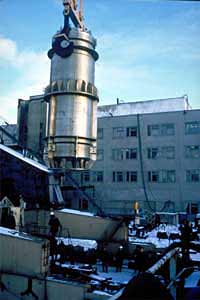Elena Sokova
March 25, 2002

Russia Shipping Damaged Fuel,
Source: Bellona
Five months ago the Head of the Russian Federal Inspectorate for Nuclear and Radiation Safety (Gosatomnadzor) warned the Russian government about the possible deterioration of radiation safety and nuclear nonproliferation efforts if the military continues to neglect safety and accounting procedures in the handling of naval spent nuclear fuel. In December 2001, Krasnoyarsk environmental organizations provided the national newspaper Izvestiya with a copy of a letter from Chairman of Gosatomnadzor Yuriy Vishnevskiy to Deputy Prime Minister Ilya Klebanov on this issue. The full text (in Russian and English) of the letter was subsequently published on the website of the Krasnoyarsk-based NGO Citizen’s Center on Nuclear Non-Proliferation.
The letter, dated October 22, 2001, charges that the Ministry of Defense is violating nuclear and radiation safety and material accounting procedures when handling spent fuel from nuclear submarines. The letter details violations that occurred in May 2001, when a shipment of spent nuclear fuel was sent from military unit No. 95404 to the Mayak Production Association in Chelyabinsk oblast. (1) The Norwegian environmental organization Bellona reported in January 2002 that the damaged nuclear fuel was sent to Mayak from the Polyarninskiy Shipyard on the Kola Peninsula. It added that the fuel came from the Echo-II class submarine K-192 stationed at Polyarnyy since 1994 and defueled in 2000. (2) Echo-II class submarines belong to the first generation of Russian nuclear submarines and are equipped with two pressurized water reactors. The fuel for this type of reactor contains highly enriched uranium (21 percent U-235).
According to a 1996 Bellona report, there was an accident on the K-192 in 1989. During the emergency shut-down of one of its two reactors, some fuel assemblies overheated and cracked. Defueling of the K-192’s reactors was delayed for over a decade due to dangerously high levels of radiation. (3)
According to Vishnevskiy’s letter, the military unit, against regulations, loaded the damaged spent fuel assemblies, which were missing bottom cladding, into railroad containers and sent them to Mayak. Mayak was not informed that the shipment included damaged fuel elements, and by mere luck this serious safety breach did not cause a major accident or harm to Mayak employees. (4) According to Bellona, Mayak cannot reprocess damaged nuclear fuel and could have refused to accept the shipment altogether, if properly notified. The Bellona report suggests that the military inspectors deliberately ignored the damage to the fuel in order to get rid of it. Current Northern Fleet nuclear fuel storage sites are full. In addition, there is no established procedure for managing damaged nuclear fuel from submarine reactors. (5)
When the containers were opened at Mayak, it turned out that part of the spent fuel was missing; some assemblies held only half of their designated content. An inspection also found cracks in parts of special railroad cars and in welded joints of containers that delivered the fuel. These findings generated an emergency search for “the missing nuclear fuel.” The material was not located, but the investigation concluded that the material missing from the fuel assemblies “was lost at the facility that supplied the fuel.” (6)
In his October 2001 letter Vishnevskiy notes that there have been other cases in which the Ministry of Defense has neglected safety and accounting standards in handling nuclear submarine fuel, although he does not provide any details in his letter. Safety and security shortcomings at naval sites are in part the result of the absence of nuclear and radiation safety oversight. (7) Under pressure from Minatom and the Ministry of Defense, Gosatomnadzor was stripped of its inspection rights over military and naval nuclear facilities in 1995.
Vishnevskiy has called for an immediate investigation into the whereabouts of the missing spent fuel and a thorough review of Ministry of Defense safety and security practices. He states that the “unclear situation with regard to accounting and control of nuclear materials at Ministry of Defense sites” raises concerns about the possible proliferation of nuclear materials. (8) He also has called for independent oversight of military nuclear facilities, but this seems unlikely to happen due to Gosatomnadzor’s weak position in the Russian ministerial hierarchy.
Notes
(1) Yu.G. Vishnevskiy, “O bezopasnosti transportirovaniya radioaktivnykh materialov (letter to I.I. Klebanov,)” No. 7-11/821, 22 October 2001; in “Gosatomnadzor Rossii byet trevogu po povodu kraine neudovletvoritelnogo obespecheniya bezopasnosti pri osushchestvlenii vyvoza OYaT na PO ‘Mayak,'” NuclearNo.ru, 26 December 2001.
(2) Igor Kudrik, “Russian Nuclear Regulatory alarms cabinet,” 30 January 2002, www.bellona.no.
(3) Bellona, “The Russian Northern Fleet,” Report 2: 1996, www.bellona.no.
(4) Yu.G. Vishnevskiy, “O bezopasnosti transportirovaniya radioaktivnykh materialov (letter to I.I. Klebanov).”
(5) Igor Kudrik, “Russian Nuclear Regulatory alarms cabinet.”
(6) Yu.G. Vishnevskiy, “O bezopasnosti transportirovaniya radioaktivnykh materialov (letter to I.I. Klebanov).”
(7) Ibid.
(8) Ibid.
